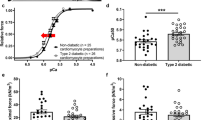Abstract
Metabolic and circulatory disorders such as diabetes and hypertension are associated with cardiac dysfunction. Research on these types of experimental animals has observed abnormal calcium (Ca2+) sparks and waves in cells; a potential mechanism altering excitation–contraction (e–c) coupling in the myocardium. The e–c coupling depends on the intricate spatial relationship between the sarcolemma and sarcoplasmic reticulum calcium release units (CRU’s). The objective of this study was to assess for a presence or absence of abnormalities in CRU’s from type II diabetic and hypertensive rat models. Myocardial tissue underwent perfusion fixation followed by selective staining of the CRU’s and the features observed using a high voltage electron microscope. Results revealed both diabetic groups had significant increases in body weight, a tendency toward an enlarged heart, and a significant disruption of the CRU’s and displacement of transverse (t)-tubules in a longitudinal direction. The hypertensive model characteristically showed a dramatic increase in heart size, a significant increase in disrupted CRU’s and a tendency towards longitudinal t-tubule orientation. We propose the two disorders of diabetes and hypertension have a similar etiology of cardiomyopathy resulting, in part, from an increase in the number of incomplete CRU’s, due to a morphological change in the architecture and orientation of the t-tubules. These architectural changes could potentially explain the impaired calcium signaling previously observed in diabetic and hypertensive cardiomyopathy.



Similar content being viewed by others
References
Belke DD, Dillmann WH (2004) Altered cardiac calcium handling in diabetes. Curr Hypertens Rep 6(6):424–429
Bers DM (2002) Cardiac excitation-contraction coupling. Nature 415:198–205
Bers DM, Eisner DA, Valdivia HH (2003) Sarcoplasmic Reticulum Ca2+ and Heart Failure Roles of Diastolic Leak and Ca2+ Transport. Circ Res 93(6):487–490
Chien KR, Olson EN (2002) Converging pathways and principles in heart development and disease: CV@CSH. Cell 110(2):153–162
Eisenberg BE (1983) Quantitative ultrastructure of mammalian skeletal muscle. In: Peachey LD (ed) Handbook of Physiology, Sect. 10, Skeletal Muscle. American Physiological Society, Bethesda, pp 73–112
Engel J (1994) Electron microscopy of extracellular matrix components. Methods Enzymol 245:469–488
Forbes MS, Plantholt BA, Sperelakis N (1977) Cytochemical staining procedures selective for sarcotubular systems of muscle: modifications and applications. J Ultrastruct Res 60(3):306–327
Franzini-Armstrong C (1970) Studies of the triad. I. Structure of junction in frog twitch fibers. J Cell Biol 47:488–499
Franzini-Armstrong C (1991) Simultaneous maturation of transverse tubules and sarcoplasmic reticulum during muscle differentiation in the mouse. Dev Biol 146(2):353–363
Ganguly PK, Pierce GN, Dhalla KS, Dhalla NS (1983) Defective sarcoplasmic reticular calcium transport in diabetic cardiomyopathy. Am J Physiol 244(6):E528–E535
Gomez AM, Valdivia HH, Cheng H, Lederer MR, Santana LF, Cannell MB, McCune SA, Altschuld RA, Lederer WJ (1997) Defective excitation-contraction coupling in experimental cardiac hypertrophy and heart failure. Science 276:800–806
Howarth FC, Jacobson M, Naseer O, Adeghate E (2005) Short-term effects of streptozotocin-induced diabetes on the electrocardiogram, physical activity and body temperature in rats. Exp Physiol 90(2):237–245
Lacombe VA, Viatchenko-Karpinski S, Terentyev D, Sridhar A, Emani S, Bonagura JD, Feldman DS, Györke S, Carnes CA (2007) Mechanisms of impaired calcium handling underlying subclinical diastolic dysfunction in diabetes. Am J Physiol Regul Integr Comp Physiol 293(5):R1787–R1797
Mobley BA, Eisenberg BR (1975) Sizes of components in frog skeletal muscle measured by methods of stereology. J Gen Physiol 66:31–45
Owan TE, Redfield MM (2005) Epidemiology of diastolic heart failure. Prog Cardiovasc Dis 47(5):320–332
Pereira L, Matthes J, Schuster I, Valdivia HH, Herzig S, Richard S, Gómez AM (2006) Mechanisms of [Ca2+]i transient decrease in cardiomyopathy of db/db type 2 diabetic mice. Diabetes 55(3):608–615
Piccini JP, Klein L, Gheorghiade M, Bonow RO (2004) New insights into diastolic heart failure: role of diabetes mellitus. Am J Med 116(Suppl. 5A):64S–75S
Pieske B, Maier LS, Bers DM, Hasenfuss G (1999) Ca2+ handling and sarcoplasmic reticulum Ca2+ content in isolated failing and nonfailing human myocardium. Circ Res 85(1):38–46
Shimoni Y, Firek L, Severson D, Giles W (1994) Short-term diabetes alters K+ currents in rat ventricular myocytes. Circ Res 74(4):620–628
Sommer JR, Waugh RA (1976) The ultrastructure of the mammalian cardiac muscle cell–with special emphasis on the tubular membrane systems. Am J Pathol 82(01):192–232
Song LS, Sobie EA, McCulle S, Lederer WJ, Balke CW, Cheng H (2006) Orphaned ryanodine receptors in the failing heart. Proc Natl Acad Sci USA 103(11):4305–4310
Tomita Y, Ferrans VJ (1987) Morphological study of sarcoplasmic reticulum in the atrioventricular node and bundle cells in guinea pig hearts. Am J Anat 180:100–122
Wehrens XH, Marks AR (2003) Altered function and regulation of cardiac ryanodine receptors in cardiac disease. Trends Biochem Sci 28(12):671–678
Wold LE, Dutta K, Mason MM, Ren J, Cala SE, Schwanke ML, Davidoff AJ (2005) Impaired SERCA function contributes to cardiomyocyte dysfunction in insulin resistant rats. J Mol Cell Cardiol 39(2):297–307
Xu M, Zhou P, Xu SM, Liu Y, Feng X, Bai SH, Bai Y, Hao XM, Han Q, Zhang Y, Wang SQ (2007) Intermolecular failure of L-type Ca2+ channel and ryanodine receptor signaling in hypertrophy. PLoS Biol 5(2):e21
Yaras N, Ugur M, Ozdemir S, Gurdal H, Purali N, Lacampagne A, Vassort G, Turan B (2005) Effects of diabetes on ryanodine receptor Ca release channel (RyR2) and Ca2+ homeostasis in rat heart. Diabetes 54(11):3082–3088
Zhang L, Cannell MB, Phillips AR, Cooper GJ, Ward ML (2008) Altered calcium homeostasis does not explain the contractile deficit of diabetic cardiomyopathy. Diabetes 57(8):2158–2166
Acknowledgments
This work was supported in part by a Grant-in-Aid for Scientific Research (B, project nos. 17300210 and 20300217 to H. Takekura) from the Japan Society for the Promotion of Science in 2005 and 2008, and by a Grant-in-Aid for Scientific Research from the National Institute of Fitness and Sports (President’s Discretionary Budget 2007 and 2008 to H. Takekura).
Author information
Authors and Affiliations
Corresponding author
Rights and permissions
About this article
Cite this article
McGrath, K.F., Yuki, A., Manaka, Y. et al. Morphological characteristics of cardiac calcium release units in animals with metabolic and circulatory disorders. J Muscle Res Cell Motil 30, 225–231 (2009). https://doi.org/10.1007/s10974-009-9191-z
Received:
Accepted:
Published:
Issue Date:
DOI: https://doi.org/10.1007/s10974-009-9191-z




